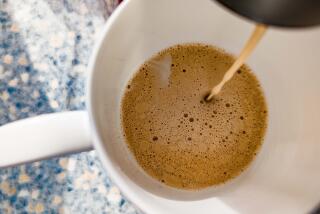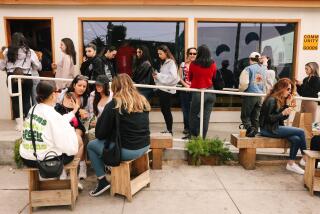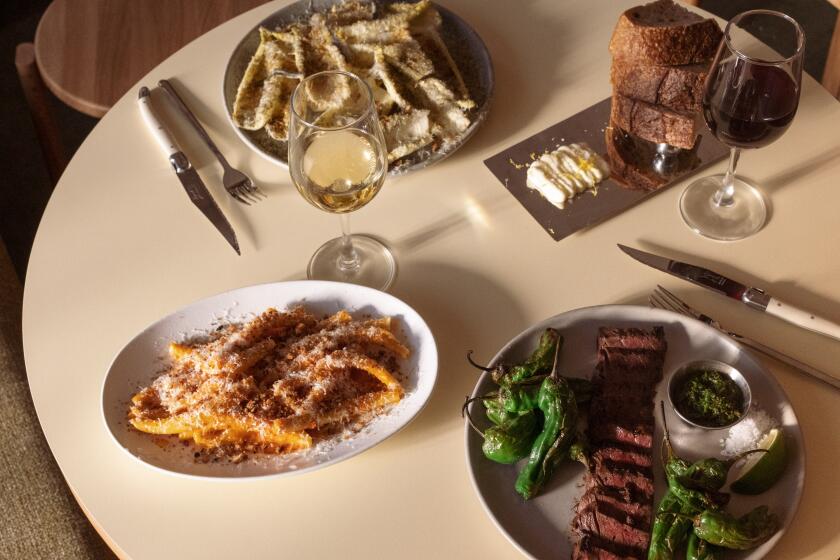The Coffee Revolution : In a Professional Cupping Room : Buyer: Tim Castle, greenbroker, gives us a taste of the real thing.
In his West L.A. cupping room, Tim Castle stokes up the Probat taster’s roaster. It’s a miniature version of a professional coffee-roasting machine: two sleek brass barrels rotating over gas flames like coffee-can-sized cement mixers. The roar of a fan fills the room, sucking away the roasting gases, which would otherwise overwhelm us, and sending them up a chimney.
From time to time he sticks a long-handled spoon into a rotating barrel and extracts a sample of beans to assess the roast. Technically, for a commercial roast the beans are heated to 390 to 405 degrees and for a dark roast to 435 to 440 degrees, but the eye is the traditional judge.
For the record:
12:00 a.m. Sept. 19, 1991 For the Record
Los Angeles Times Thursday September 19, 1991 Home Edition Food Part H Page 43 Column 1 Food Desk 3 inches; 80 words Type of Material: Correction
Coffee--Last week’s article “In a Professional Cupping Room” incorrectly referred to Tim Castle’s coffee firm as Inter Trade. Inter Trade is a firm solely owned by Alexander Castle, and Tim Castle has no interest in it. Tim Castle is the sole shareholder of Castle & Co., a company that has sought protection from its creditors under Chapter 11 of the bankruptcy court. Alexander Castle did not own coffee farms in Guatemala while Tim Castle worked for Inter Trade; accordingly, Tim Castle never found that Alexander Castle’s coffee farms were not among Guatemala’s best.
When the roasting has reached the point he wants, Castle pulls a handle, the barrels tip their contents onto a grate and the fan automatically switches gears and starts sucking air over the grate to cool the beans. (Coffee beans aren’t at their best for tasting immediately after being roasted--they give off small quantities of unpleasant-tasting gases for a few hours.) You really don’t need your own roaster to enjoy good coffee. Still, you can imagine any foodie wanting to own one of these neat little gadgets, which couldn’t cost more than a couple of thousand dollars.
Castle, whose wry, hesitant manner recalls Robert Downey Jr., is a foodie himself. At one time, he was a dealer in, and an impassioned champion of, Oregon wines and truffles. These days he’s a “specialty greenbroker”--a dealer in premium-quality raw coffee beans. He’s also the president (and former vice president) of the Specialty Coffee Assn. of America, the editor of the SCAA newsletter, the West Coast correspondent for Tea & Coffee Trade Journal and the author of a recently released book on coffee called “The Perfect Cup: A Coffee Lover’s Guide to Buying, Brewing and Tasting” (Aris/Addison Wesley, 1991: $10.95).
Castle got into the coffee trade 13 years ago when his father’s trading partners bought some farms in Guatemala. None of them knew anything about coffee, but they did know Tim had gotten interested in coffee when he was in college. He is one of several important West Coast coffee figures who first got turned on by Peet’s in Berkeley.
He had a lot to learn. One of them was that the coffee farms his father owned were not among Guatemala’s best and had to be sold. But persistence pays off.
The cupping room at his company, Intertrade, is set aside exclusively for tasting coffee in the formal style known as cupping. (See Cupping sidebar.) The room is equipped with a Lazy Susan table and some brass spittoons for an obvious taster’s purpose.
He purposely overroasted one of the samples to make a point about dark roasts (“Smell that barbecue,” he says, and there is indeed a smell like wood smoke in the air). The usual “cupping roast” is actually fairly light. “It’s not necessarily the best for drinking,” he says, “but it shows all the flavor elements, it makes visible flaws that might get roasted away.”
The light-roasted coffee is also more acid and has less “coffee” flavor than even the rather light roast used in canned coffee. “On the coffee farms, they drink a very light roast,” says Castle. “They consider it a fruit beverage rather than a roasted grain.” Logical, perhaps, but strange.
We taste some coffees. I’ve been drinking coffee most of my life and consumed vast quantities of Peet’s when I was at college myself. But now it strikes me that I still can’t say much about coffee beyond whether I like it or not.
“Very acidy,” Castle says of a Kenya AA. What does that mean, I wonder? But then I retaste it after some Guatemalan, and I realize it’s downright sour--not the sourness of vinegar or lemon juice or yogurt, but sour with a coffee acidity I’ve actually been tasting all these years.
I guess I can detect a wine-like quality in the Yemen Borahi in the next cup. But is it, technically speaking, acid? Judging acidity, which would seem to be as natural as falling off a log, begins to seem as rare an ability as perfect pitch.
Fortunately, Castle is sympathetic to all of us who are trying to learn about coffee.
“People always want to know what’s the best coffee, and I always try to dispel that. There are a lot of valid approaches. It’s dangerous to play favorites at this point.
“I’ve been tasting coffee professionally for 13 years, and I feel I’m pretty good for somebody who’s only been doing it for 13 years. But I have a lot to learn.”
More to Read
Eat your way across L.A.
Get our weekly Tasting Notes newsletter for reviews, news and more.
You may occasionally receive promotional content from the Los Angeles Times.










